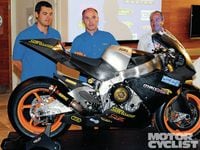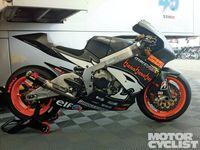When MotoGP replaced the 250cc two-strokes with the new 600cc four-stroke Moto2 class in 2010, the response almost overwhelmed the organizers. From the very first race the grids were full, with more than 40 bikes lining up. There were several chassis choices, good racing, good sponsorship response and good entertainment value.
It’s hardly surprising, then, that MotoGP is set to replace the 125cc two-strokes with a 250cc four-stroke class beginning next year. Like the Moto2 bikes, these Moto3 machines will use “prototype” chassis and production-based engines. Unlike Moto2, however, there will not be a spec engine for Moto3. There should be plenty of bikes lining up for the first race.
While Moto2 and Moto3 are set to prosper, MotoGP languishes. The grids are small, with just 17 bikes forming the official field. Of those, there are nine “factory” bikes and eight “satellite” entries. There are only four makes represented, with Honda, Yamaha and Ducati fully committed, and Suzuki running one bike out of a significantly smaller operation. Kawasaki is no longer involved, having switched its focus to World Superbike, along with Aprilia and BMW.
MotoGP bikes are pure prototypes—both engine and chassis. The biggest bike supplier, Ducati, provides machines to six riders spread over four teams. With two bikes per rider, that’s 12 bikes to minister over a race weekend, so these bikes are not exactly one-offs. But they are expensive: The lease price of two bikes for a one-rider team, including spares and the year’s maximum six engines, is said to be upwards of $4.5 million.
Costs at that level basically determine the size of the field. Only 10 teams have managed to find the funding they need. Small grids hurt the entertainment level of the series, but the two-tier factory/satellite rankings also mean that more than half the field has little chance of scoring a podium finish, and this also thins spectator attendance and television viewing audiences.
To bring new entrants to the premier class, MotoGP is drawing on lessons learned from its Moto2/3 experience. All the 2012 MotoGP bikes will run 1000cc engines, but a new category of entrant will be allowed: the CRT, or Claiming Rule Team. These teams will use prototype chassis similar to those in Moto2, but production-based engines, likely those currently employed in World Superbike.
The current MSMA (manufacturers’ association) teams will use prototype engines with an allowance of six engines per year and a fuel capacity of 21 liters. The CRT teams will be allowed 12 engines and 24 liters. Engine cost will effectively be limited by the claiming rule, which says that an MSMA member can claim a CRT engine for €20,000 ($28,500) or €15,000 ($21,000) less transmission. CRT teams can spend more than that on their engines, but they risk losing them if they do.
How will this work in practice? Will MotoGP go from being two tiers to three, with the factory bikes fastest, then the satellites, then the CRTs? Will the CRT machines be significantly less expensive and bring a lot of new teams to the grid?
Eskil Suter, long-time MotoGP designer/builder and manufacturer of a successful Moto2 machine, is already testing a BMW S1000RR-powered MotoGP machine based on the CRT rules. He figures a CRT program will cost substantially less than a current satellite effort, but still might exceed €1 million ($1.4 million). His company will make the bike he’s currently testing available for next season, and later this summer we should have a good idea of how competitive it will be in terms of lap times. The CRT bikes won’t be cheap, and may not be equal to the satellite bikes. So why build and race them?
I figure the eventual purpose here is to convert MotoGP to a prototype frame/production-based engine class similar to Moto2/3, over the course of several seasons. The manufacturers are heavily invested in their MotoGP prototypes, so don’t want them to disappear overnight. But everyone is looking at cost and grid sizes.
By introducing the CRT entries concurrently with existing MSMA teams, the organizers are testing the waters. If these bikes prove to be fast, less expensive, reliable and entertaining, we may see the current prototypes phased out through rule changes that increasingly favor the CRTs. Might the claiming-rule teams eventually claim a place at the top level of racing?













/cloudfront-us-east-1.images.arcpublishing.com/octane/ITNLTIU5QZARHO733XP4EBTNVE.jpg)
/cloudfront-us-east-1.images.arcpublishing.com/octane/VZZXJQ6U3FESFPZCBVXKFSUG4A.jpg)
/cloudfront-us-east-1.images.arcpublishing.com/octane/QCZEPHQAMRHZPLHTDJBIJVWL3M.jpg)
/cloudfront-us-east-1.images.arcpublishing.com/octane/HXOUJXQWA5HBHGRO3EMJIGFMVI.jpg)

/cloudfront-us-east-1.images.arcpublishing.com/octane/3TIWWRV4JBBOLDVGRYECVVTA7Y.jpg)
/cloudfront-us-east-1.images.arcpublishing.com/octane/KIX5O23D5NAIBGFXBN3327DKZU.jpg)
/cloudfront-us-east-1.images.arcpublishing.com/octane/7GJYDUIPXRGMTMQKN6ONYOLBOU.jpg)
/cloudfront-us-east-1.images.arcpublishing.com/octane/MUQLOVLL2ZDGFH25ILABNBXKTI.jpg)
/cloudfront-us-east-1.images.arcpublishing.com/octane/TNOU5DNE2BC57MFPMGN2EIDXAM.jpg)
/cloudfront-us-east-1.images.arcpublishing.com/octane/GTCXACQGJ5HAPDTGWUQKDEH44E.jpg)
/cloudfront-us-east-1.images.arcpublishing.com/octane/S35YGSEMEZB4BLTDJTSZPF4GLA.jpg)
/cloudfront-us-east-1.images.arcpublishing.com/octane/5UOT6HPX2JFMRJAX6EH45AR4MQ.jpg)
/cloudfront-us-east-1.images.arcpublishing.com/octane/OKWOJWAKP5EP3OACCRRWPCIX2Q.jpg)
/cloudfront-us-east-1.images.arcpublishing.com/octane/2WF3SCE3NFBQXLDNJM7KMXA45E.jpg)
/cloudfront-us-east-1.images.arcpublishing.com/octane/G4MG6OUCJNBSHIS2MVVOTPX65E.jpg)
/cloudfront-us-east-1.images.arcpublishing.com/octane/IIGGWFOTOJGB7DB6DGBXCCMTDY.jpg)
/cloudfront-us-east-1.images.arcpublishing.com/octane/QSTCM6AVEZA5JJBUXNIQ3DSOF4.jpg)
/cloudfront-us-east-1.images.arcpublishing.com/octane/U4I7G625B5DMLF2DVIJDFZVV6M.jpg)
/cloudfront-us-east-1.images.arcpublishing.com/octane/B6XD6LS6IVCQPIU6HXDJSM3FHY.jpg)
/cloudfront-us-east-1.images.arcpublishing.com/octane/ICL63FEDDRDTTMINYICCEYGMDA.jpg)
/cloudfront-us-east-1.images.arcpublishing.com/octane/FCGZHQXRBZFLBAPC5SDIQLVF4I.jpg)
/cloudfront-us-east-1.images.arcpublishing.com/octane/WNOB6LDOIFFHJKPSVIWDYUGOPM.jpg)
